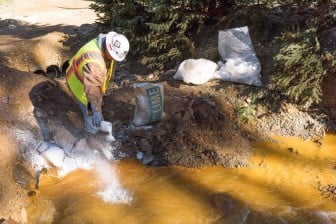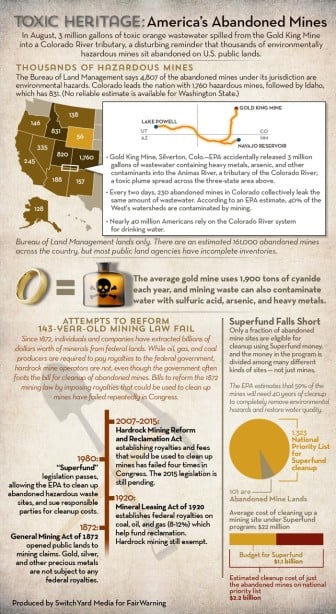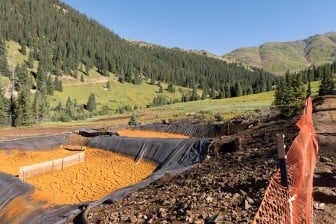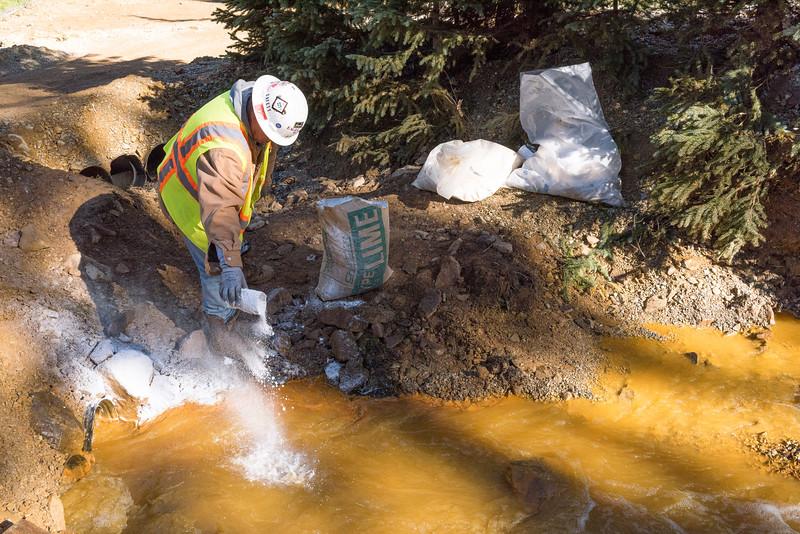
As water exits the mine, it flows into a system of four treatment ponds. The treatment ponds provide retention time to allow the pH to adjust. Here, lime is added to a settling pond to assist in the pH adjustment of the water prior to discharge to Cement Creek on Aug 14, 2015. (Credit: Eric Vance/EPA)
When millions of gallons of wastewater poured into the Animas River in August, people watched in horror as the river turned orange, then continued flowing into the San Juan River, a tributary of the Colorado River.
Contractors hired by the US Environmental Protection Agency were working on a cleanup project at the abandoned Gold King Mine outside of Silverton, CO when they triggered a “blowout” and released three million gallons of wastewater into a creek that flows into the Animas.
On the Navajo Nation, farmers who rely on the river’s water for crops closed their irrigation gates, even after the federal government assured people that the river’s levels of lead, arsenic and cadmium were safe again—and the tribe continues to question the government’s actions and cleanup work.
The Gold King Mine accident generated plenty of attention this summer—but it isn’t the only abandoned mine out there.
And it doesn’t take an accident for water contamination to occur.
 A new infographic produced for FairWarning.org, a nonprofit news outlet that focuses on safety, health and corporate conduct, shows how pervasive the problem is across the western United States.
A new infographic produced for FairWarning.org, a nonprofit news outlet that focuses on safety, health and corporate conduct, shows how pervasive the problem is across the western United States.
In Colorado alone, 230 abandoned mines collectively leak three million gallons of wastewater every two days. And according to the EPA, forty percent of the West’s watersheds are contaminated by mining.
As Bridget Huber writes at FairWarning.org:
Many of these abandoned mines are on land owned by the U.S. government. But federal agencies have struggled with the problem for years, in part because some of the sites were abandoned as long as a century ago by companies that no longer exist. There isn’t even a reliable count of the number of abandoned U.S. mines, according to the Government Accountability Office, though the agency has estimated that there are at least 161,000 such sites in the 12 Western states and Alaska.
In New Mexico there are 15,000 abandoned mines, according to the New Mexico Energy, Minerals and Natural Resources Department’s Abandoned Mine Land Program. That’s only an estimate, however, as “the numbers of abandoned mines in the state are so numerous that one can only guess at their quantity.”

Settling ponds used to precipitate iron oxide and other suspended materials from nearby Red and Bonita mines drainage are shown in this Aug. 14 photo. (Credit: Eric Vance/EPA)
According to the US Bureau of Reclamation’s report on the Gold King Mine accident, the conditions and actions that led to the Gold King Mine release “are not isolated or unique, and in fact are surprisingly prevalent.”
Standards of practice for reopening and remediating abandoned mines—as contractors were trying to do at Gold King Mine—are inconsistent from one agency to another and while there are guidelines, the report’s authors note that “there is little in actual written requirements that government agencies are required to follow when reopening an abandoned mine.”
